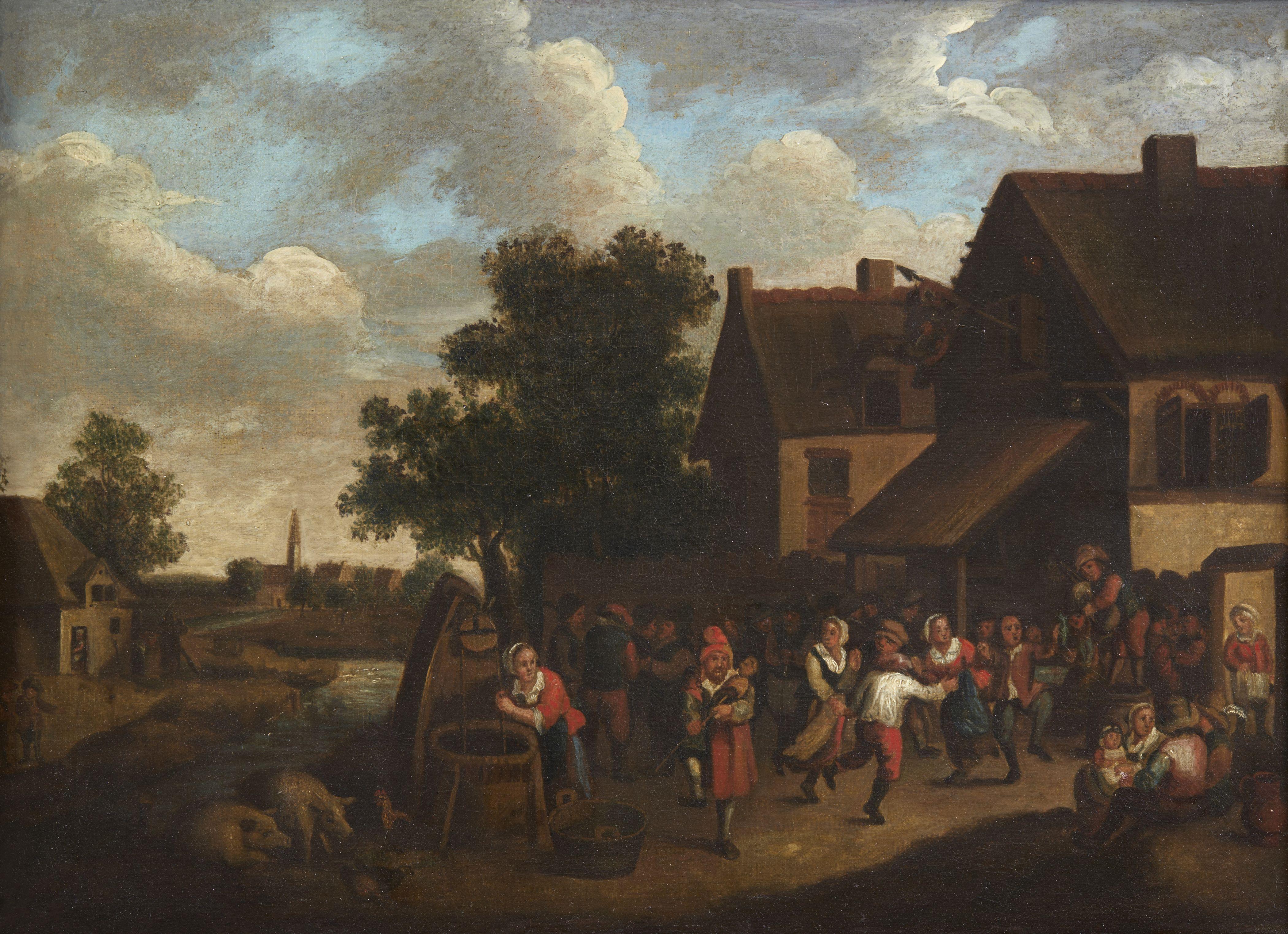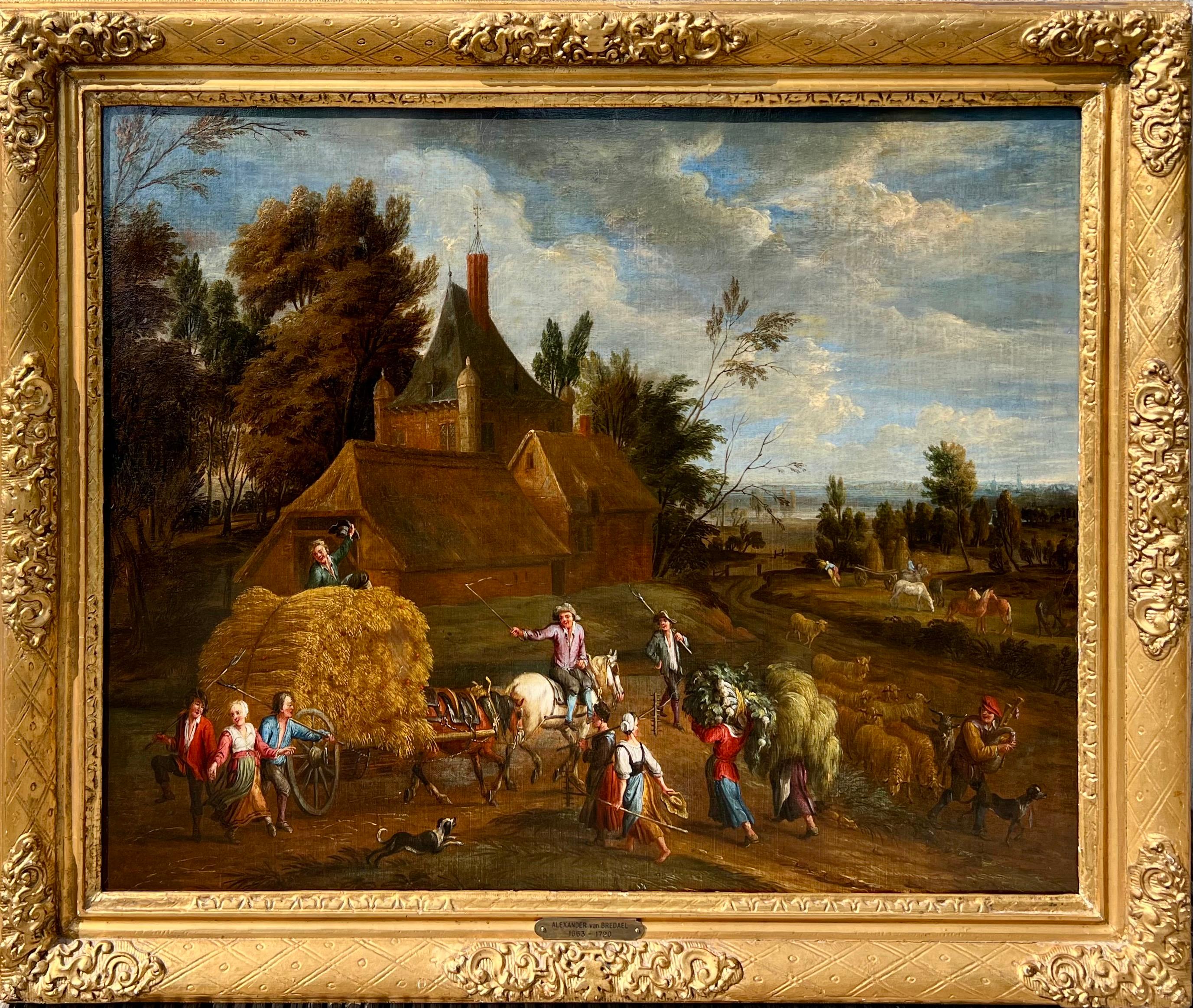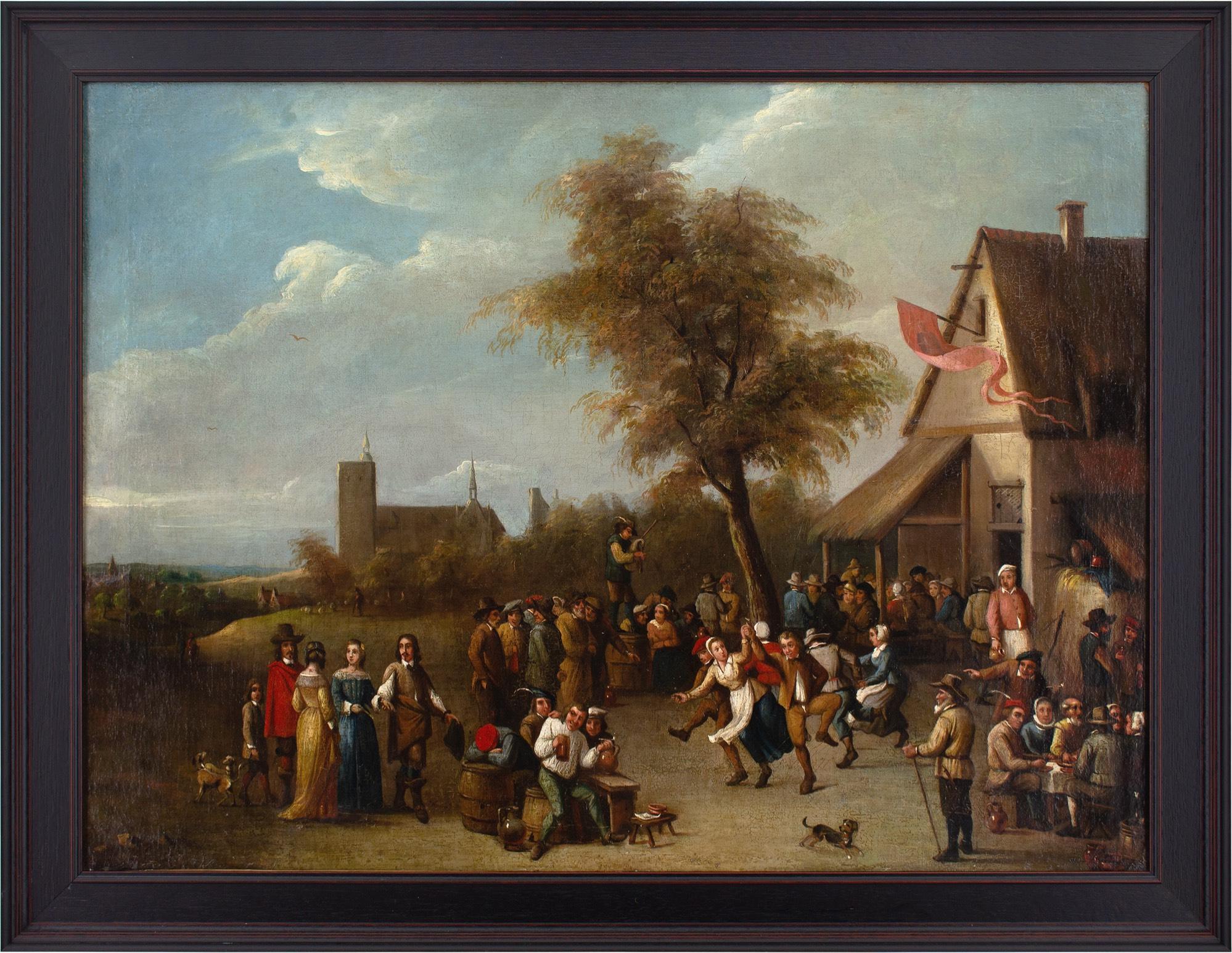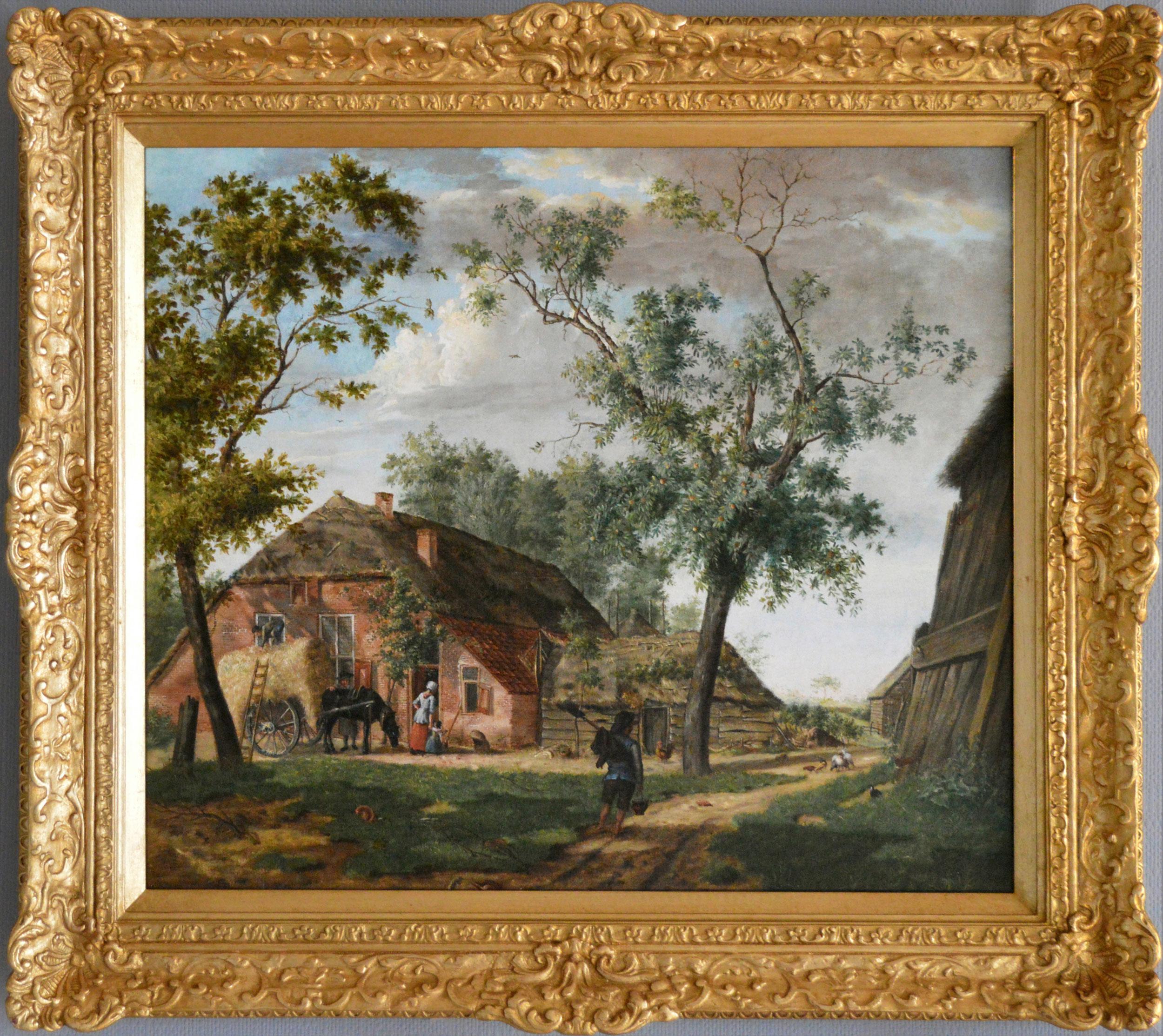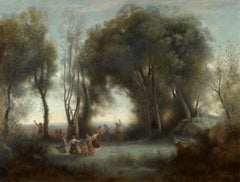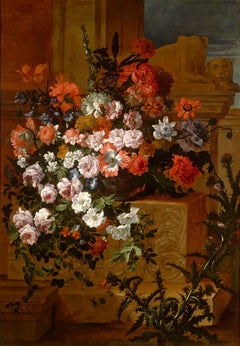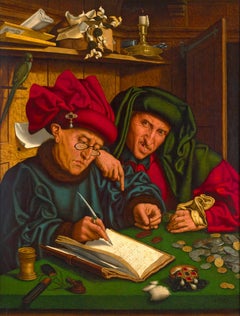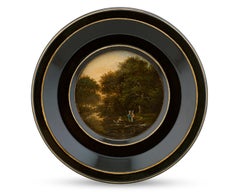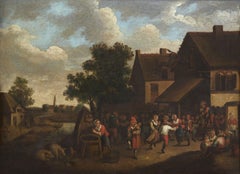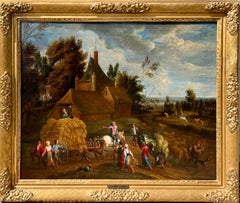Articoli simili a Una scena di campagna contadina di Jan Thomas van Kessel
Vuoi altre immagini o video?
Richiedi altre immagini o video al venditore
1 di 8
Jan Thomas van KesselUna scena di campagna contadina di Jan Thomas van Kessel18th Century
18th Century
174.678,03 €
Informazioni sull’articolo
Jan Thomas van Kessel
1677-1741 Flemish
A Peasant Country Scene
Signed (lower left)
Oil on canvas
A quintessential example of Flemish genre painting, A Peasant Country Scene reflects a blend of the playfulness of subject and the technical acuity that defined the style of 18th-century Flemish painter Jan Thomas van Kessel. The artist invites viewers into a merry gathering of peasants that spills across the composition. Highlighted at its center is a couple in the midst of a lively dance, their direct gaze out at the viewer conveying their happiness, while also serving as an effective means to pull the viewer's eye into the festivities underway.
This gathering of merry revelers assumes a stage-like quality as they are separated visually from the far reaches of the composition by a fence that bisects the composition horizontally, underscoring the intimate feel of the foreground scene. Beyond this enclosure, a farmhouse looms over the scene and opens at right onto a sweeping landscape that carries the eye back into the distant horizon. Here, too, the eye is guided appropriately, as figures dot the path down the river toward the steeple of a church just visible along the horizon line. Overhead, a breathtakingly blue sky, dappled with billowy clouds and soaring birds, complements the festive scene.
Such genre paintings were incredibly popular during the 17th and 18th centuries, as they served as a reminder of the simple pleasures of pastoral life. Such scenes first emerged during the 16th century in the wake of the Reformation as artists sought new fields of painting in which to showcase their skill. Key figures such as David Teniers the Younger and the Brueghel family ensured the genre's success into the 17th century when they became highly fashionable. This enduring popularity thereby afforded later artists like van Kessel the opportunity to showcase their talents in conjuring such engaging vignettes.
Van Kessel clearly capitalized on that popularity, as he developed a following for his works that served as a visual escape from the realities of city life. Little is known of van Kessel's life, save for that he was born in Flanders in 1677 and studied both with the masters of Antwerp's Guild of Saint Luke, and even purportedly trained in Paris. Van Kessel then established his studio in his hometown of Antwerp just after the dawn of the 18th century. Aiding in van Kessel's rapid development as an artist was undoubtedly the fact that he descended from a long family line of painters who explored various subjects from botanical studies to portraits. It is arguably van Kessel's inviting scenes of peasants and pastoral life, as seen in this composition, however, that are the most engaging of his family's oeuvre and earned the artist acclaim for his work in Antwerp and beyond.
One point often noted in van Kessel's genre paintings are the references he makes to past masters like Teniers, and these connections are tangible in this painting. The layout of this composition, from the cluster of animated figures in the foreground contrasted against the serene expanse of nature in the distance, seem to be direct quotations of Teniers' work. This reinforces both the placement of this work within the 18th century – following Teniers' lifetime – and within van Kessel's body of work. The connection of this painting to Jan Thomas van Kessel's oeuvre is without dispute, however, as this painting benefits from the scrolling script of the artist's signature along the lower edge.
Only a handful of van Kessel's works, including those held by prestigious collections such as England's National Trust and the Museum Catharijneconvent in the Netherlands, have been fully documented. As a result, it is rare when such a well-preserved example of this 18th-century Flemish genre painting tradition emerges, and it is particularly exciting when such a find contributes to the emerging legacy of a little-understood artist of the era.
Canvas: 40 1/4" high x 54 1/4" wide
Frame: 52 3/4" high x 66 5/8" wide
- Creatore:Jan Thomas van Kessel (1677 - 1741, Fiammingo)
- Anno di creazione:18th Century
- Dimensioni:Altezza: 133,99 cm (52,75 in)Larghezza: 169,25 cm (66,63 in)Profondità: 7,62 cm (3 in)
- Tecnica:
- Movimento e stile:
- Periodo:
- Condizioni:
- Località della galleria:New Orleans, LA
- Numero di riferimento:Venditore: 31-01981stDibs: LU18615260042
Informazioni sul venditore
5,0
Venditore professionale selezionato
Ogni venditore supera rigorosi standard di autenticità e affidabilità
Fondazione nel 1912
Venditore 1stDibs dal 2013
17 vendite su 1stDibs
Tempo di risposta standard: 11 ore
- SpedizioneRecupero del preventivo…Spedizione da: New Orleans, LA
- Politica di reso
Alcune parti di questa pagina sono state tradotte automaticamente. 1stDibs non può garantire che le traduzioni siano corrette. L’inglese è la lingua predefinita del sito.
Garanzia di autenticità
Nell’improbabile caso in cui si verifichi un problema con l’autenticità di un articolo, contattaci entro un anno per ottenere un rimborso completo. DettagliGaranzia di rimborso
Se il tuo articolo non corrisponde alla descrizione, è danneggiato durante il trasporto o non arriva, contattaci entro 7 giorni per un rimborso completo. DettagliAnnullamento entro 24 ore
Hai un periodo di tolleranza di 24 ore per annullare il tuo acquisto, senza necessità di fornire spiegazioni.Venditori professionali selezionati
I nostri venditori di livello internazionale devono aderire a rigorosi standard di servizio e qualità, garantendo l’integrità delle inserzioni.Garanzia miglior prezzo
Se scopri che un venditore ha pubblicato altrove lo stesso articolo a un prezzo più basso, applicheremo lo stesso prezzo.Consegna globale affidabile
La nostra rete di vettori leader del settore offre opzioni di spedizione specializzate in tutto il mondo, inclusa la consegna personalizzata.Altro da questo venditore
Mostra tuttoDanza delle Ninfe
Di Paul Desire Trouillebert
Questo paesaggio lirico intitolato Danza delle Ninfe è stato composto dal pittore francese di Barbizon Paul Désiré Trouillebert. Una scena gioiosa di ninfe che danzano nella nebbia m...
Categoria
XIX secolo, Accademia, Dipinti (paesaggio)
Materiali
Tela, Olio
Natura morta con fiori di Jean-Baptiste Monnoyer
Di Jean-Baptiste Monnoyer
Jean-Baptiste Monnoyer
1636-1699 French
Still Life with Flowers on a Carved Stone Ledge
Oil on canvas
Impeccable detail and luminous color breathe life into this floral still lif...
Categoria
XVII secolo, Antichi maestri, Dipinti (natura morta)
Materiali
Tela, Olio
Prezzo su richiesta
Gli esattori delle tasse attribuito a Marinus van Reymerswaele
Marinus van Reymerswaele
c.1490 – c.1546 Olandese
Gli esattori delle tasse
XVI secolo
Olio su pannello di legno
Marinus van Reymerswaele è uno dei più grandi e amati artisti dell'...
Categoria
XVI secolo, Dipinti figurativi
Materiali
Olio, Pannello in legno
Miniatura tedesca di una gita in barca
Questo affascinante dipinto in miniatura tedesco, realizzato con olio su rame, raffigura una tranquilla gita in barca. Una coppia vestita in modo sontuoso sta in piedi insieme, mentr...
Categoria
XIX secolo, Antichi maestri, Dipinti (paesaggio)
Materiali
Rame
Ritratto di gentiluomo di Frans Hals
Frans Hals
1582-1666 Olandese
Ritratto di un gentiluomo
(forse Theodore Blevet)
Olio su pannello
"Frans Hals è un colorista tra i coloristi... Frans Hals avrà avuto ventisette ne...
Categoria
XVII secolo, Antichi maestri, Dipinti (ritratto)
Materiali
Olio, Pannello
Prezzo su richiesta
Jan Lutma, orafo di Rembrandt van Rijn
Di Rembrandt van Rijn
Rembrandt van Rijn
1606-1669 Olandese
Jan Lutma, L'orafo
Acquaforte, incisione e puntasecca su carta
Il secondo stato di New Hollstein su cinque
Firmato e datato "Rembrandt / F. 1...
Categoria
XVII secolo, Antichi maestri, Disegni e acquarelli figurativi
Materiali
Carta, Incisione, Puntasecca, Acquaforte
Ti potrebbe interessare anche
18th Century Landscape Flemish Scool Outdoor Peasant Oil on Canvas Brown Blue
Painting oil on canvas measuring 45 x 55 cm without frame and 65 x 75 cm with frame depicting an outdoor peasant scene from the Flemish school of the late 17th and early 18th centur...
Categoria
1690s, Scuola fiamminga, Dipinti (paesaggio)
Materiali
Tela, Oil
Grande dipinto fiammingo del XVII secolo sulla festa del raccolto - Paesaggio di campagna
Magnifico dipinto antico che raffigura una festa del raccolto in un pittoresco villaggio del XVII secolo. Il dipinto irradia pace e tranquillità con i suoi colori terrosi, il cielo a...
Categoria
XVII secolo, Antichi maestri, Dipinti figurativi
Materiali
Tela, Olio
Paesani in un paesaggio - pittura ad olio figurativa fiamminga del XVII secolo
Questo fantastico dipinto a olio Old Master fiammingo del XVII secolo è opera di Thomas Thomas Apshoven. È stato dipinto intorno al 1650 e raffigura un villaggio con figure all'ester...
Categoria
Anni 1650, Antichi maestri, Dipinti figurativi
Materiali
Olio
6600 € Prezzo promozionale
20% in meno
Cerchio di David Teniers, Paesaggio con contadini presso una locanda e un fiume, olandese
Di David Teniers the Younger
Cerchio di tenitori, contadini in un paesaggio che passa vicino a un fiume e a una locanda.
Categoria
XVII secolo, Barocco, Dipinti figurativi
Materiali
Olio, Pannello
3000 € Prezzo promozionale
25% in meno
David Teniers the Younger (dopo), Celebrazione del paese
Di David Teniers the Younger
Questo affascinante dipinto a olio della metà del XVIII secolo raffigura una vera e propria schiera di festaioli che banchettano vicino a una taverna. Si tratta di un'opera dell'arti...
Categoria
Anni 1750, Dipinti figurativi
Materiali
Olio, Tela
Paesaggio del primo Ottocento dipinto a olio di una fattoria
Di Hermanus van Brussel
Hermanus van Brussel
Olandese, (1763-1815)
L'aia
Olio su tela
Dimensioni dell'immagine: 18,25 pollici x 21,25 pollici
Dimensioni comprensive di cornice: 24,5 pollici x 27,5 pollici
P...
Categoria
Inizio XIX secolo, Dipinti (paesaggio)
Materiali
Tela, Olio
